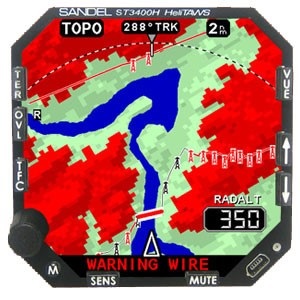In 1995, the AOPA Air Safety Foundation and the California Wire Strike Prevention Working Group jointly released the video “the terrible truth about wire strikes” and highlighted the following:
- It is estimated that 75% of the aircraft involved in these accidents were destroyed or severely damaged.
- The number of reported wire strikes in comparison to the cut wires found suggests that only 10% of wire strikes were reported.
“Most pilots assume wire strikes occur on scuddy days or during unauthorized buzzing,” said John Steuernagle, ASF’s director of program development. “But during 90 percent of wire strike accidents, the visibility was reported to be three miles or more. Nearly 85 percent of strikes occurred at ceilings higher than 1,000 feet.”
According to Steuernagle, most accidents are caused by experienced pilots operating legally
Here are some other highlights from their video 27 years ago:
- Due to their higher speed, fixed wing aircraft hit wires four times more often than helicopters.
- 70% of the events occurred at or below 1000ft.
- Bad weather is not the primary cause of accidents
The recommendations placed a great deal of emphasis on proactive measures to prevent human error:
- High recon passes and checking aeronautical charts are recommended.
- Fly over the supporting structures and not the wire spans.
- In the vicinity of wires, reduce speed
- Pulling up is the most effective way to avoid a collision
- If possible, use ground personnel to assist during remote ground operations
As a reactive measure, they recommend installing a wire strike prevention system which includes cutters above and below the cockpit and a windshield deflector.
Here is the full video for those wanting to go into details:
Over two decades later, the Helicopter Association International (HAI) released a video titled “Surviving the Wires Environment”. It has been shared by the OAS (Office of Aviation Services – Department of Interior – U.S.A), which recommends watching it for all personnel who operate in low-level environments. In the video, various types of wire hazards are highlighted along with techniques to identify and avoid them, with an emphasis on the human element.
More than 24 years after the video was made, despite the advances in technology and the evolution of aviation, aircraft are still hitting wires consistently.
Some other points of interest:
- A 30% of wire strikes involve fatalities. This value increases to 60% if the strike was unexpected and the pilot could not prepare for it.
- Whereas in the past, fixed-wing were striking wires 4 times more, this has changed.
- 40% of pilots hitting wires knew they were there.
- A high recon pass is essential.
- After scanning and looking, perceiving that a wire is there is based on memory and experience, although experience per se is no warranty to stay safe in the wire environment. Pilots involved in wire strikes average 2000hrs and 45-55 years old.
They make one last significant point: in-flight wire avoidance training that focuses on the specific hazards is the single most important thing.
In order to increase awareness during real missions, some operators attend courses for as long as six months, including CRM aspects and hazard identification.
That is probably the way to go, with the current technology we have implemented.
Here is the full video for those wanting to go into details:
SYSTEMIC VULNERABILITIES: BEYOND THE HUMAN ERROR
Both videos are great, they show will, and there are useful takeaways, but still focus a lot on human error.
Some ideas of value are:
- Reading the physical structure indicators (ie orientation of insulators, presence of bucked arms and sighting two or more poles)
- Self-discipline, pre-flight briefing, pre-flight reconnaissance and observation, memory and awareness, appropriate flying techniques, maintenance of a good visual scan, and consideration of weather factors (as also stated on BASI, 1991).
- Additionally, pilots need to guard against deviating from low-flying routes and areas previously checked for wires.
But in addition to what we already know, or should know, we need to stress that beyond procedures, systemic vulnerabilities tend to be behind individual errors.
What do I mean by that?
In the case of wire strikes, as much as we like to see them, under certain circumstances of light and background, we simply can’t see them, being part of a larger environmental and systemic, recurrent issue. We will come back to it later in the article.
“Telling a pilot not to hit those invisible wires is like telling an obese person to get slim, or a depressive person, to be happy”
We would if we could!
Therefore, we get to, and pass by quickly, over something that we might know by now, but its still worth reminding when studying wire strikes:
Human error: the older view versus the more current one
- The older view of human error: Human error is a cause of accidents. To explain failure, you must seek failure. You must find people’s: inaccurate assessments, wrong decisions, and bad judgments.
- The new view of human error: Human error is a symptom of trouble deeper inside a system. To explain failure, do not try to find where people went wrong. Instead, find how people’s assessments and actions made sense at the time, given the circumstances that surrounded them.
In summary, I believe we need better standards, and to continue improving our training programs in order to improve awareness and effective scanning, but we also need to progress in other relevant areas:
It’s all about technology here!
“Telephone did not come out of the persistent improvement of postal delivery” – Amit Kalantri.
WHAT HAS CHANGED FROM THE FIRST VIDEO UNTIL TODAY?
Despite improvements in prevention, we are still hitting wires today. The “cutting edge” technology for most aircraft remains, literally, a wire strike prevention system with cutters located above and below the cockpit.
The idea behind it is to catch and cut wires (or not), mitigating the consequences of a strike. The name wrongly implies that it prevents it from occurring, but it doesn’t. It lowers the consequences, but it does not prevent the wire strike from occurring.
Wire strikes continue to cause fatalities, and a percentage of them are not reported / not published.
The two videos focus primarily on helicopters, but the following pictures show that fixed wings are no exception.

During the approach to a fire, a Fireboss was severely damaged after hitting a wire. There is no information available from authorities that could connect this to other events and allow us to learn from it.
Only in Portugal, during the past six years, there have been six Fireboss wire strikes similar to this one. Five occurred during scooping. Two of them were exactly the same wire from one season to the next.
Here’s one:
It doesn’t take a crystal ball, nor do I need to be Einstein, to say that if the trend continues, most likely we will have another Fireboss fatal accident in Portugal, this time involving wires.
Same thing, or even worse with helicopters.
Whereas in the past, fixed-wing aircraft struck wires 4 times more, when agricultural flying was at its peak, this has changed and helicopter pilots suffer more wire strikes nowadays, due to being a popular and versatile asset for low-level flying.
Days ago, during early September 2022, we saw a catastrophic B-412 accident also in Portugal
Once again, we have seen the same kind of accident with fatal consequences, also in Portugal:
Other relevant studies:
Already in 1980, NASA released a Civil Helicopter Wire Strike Assessment Study—a report that analyzed NTSB and FAA accident reports. The study made several recommendations for interventions to mitigate the threat, such as pilot warning devices, wire cutters, and improved training. The authors concluded that pilot warning devices would have been beneficial in preventing 76% of the accidents, wire cutters would have been 49% effective, and pilot training would have made a difference in 56% of the cases.
Aviation Research and Analysis Report – B2005/0055 by Australian ATSB, suggested that the aviation industry would benefit from further research into wire-strike accidents. Evidence of the relatively high number of occurrences where the pilot was aware of the powerline before it was struck suggests that this issue warrants particular attention. Further research should also include an examination of the human factors that may be associated with the situational awareness of low-flying pilots. The Australian aviation industry would also benefit from research on measures that may assist pilots to become more attentive and alert to wires during low-level flight.
AVAILABLE TECHNOLOGY AND IDEAS
A number of onboard detection systems have been developed to warn pilots of their proximity to wires. These include:
- A system that detects the electromagnetic field generated by powerlines.
However, this system does not identify the location of the wire and will only activate if the wire is live.

- A system that utilizes lasers to scan the environment ahead of the aircraft for wires and other flight obstacles.

- A system that uses a database of terrain and wire location information to warn pilots of rising terrain and obstacles that are more than 100 feet above the ground.
Alerts for onboard detection systems can be in the form of an aural alert, which may also give an indication of the proximity of the wire, and/or a visual alert, which may be an illuminated warning light or an indication on a map display.
- Visual aids: Marker balls are hollow, fluorescent fittings placed on wires to improve their visibility.
- Other reactive measures to mitigate the consequences of wire strikes, but not the probability are wire cutters &Wire Strike Protection Systems (WSPS). Fixed-wing sometimes have deflectors on the windshield and undercarriage.
THE NEED FOR TECHNOLOGY IMPROVEMENTS AND DESIRED TECHNOLOGY BY FRONT-LINERS:
Although there have been remarkable efforts to tackle the issue during the 25 years that passed between videos, and those examples of technological improvements can help mitigate the probability of wire strikes, they are not on par with the technological revolutions we have seen in other areas.
At the end of the day, we are still hitting wires at an alarming rate!
Therefore, in addition to using some of those proven technologies, improving our procedures and training program, we also need a device that we can use during our recon pass to reveal those “invisible” wires.
This is how I see the wires when doing my recon pass for scooping:
This is how I would like to see the wires when doing my recon pass for scooping:
And I would like to see it from a visor a can pull down during my high recon pass, and pull up away, when not needed.
We would drastically increase our environmental awareness and decrease the 60% of accidents where pilots are unaware of wires.
Science fiction or reality? Well, HUDs are available and affordable, and databases of wires exist.
There are firefighting companies such as Dauntless Air, working on HUDs implementation to help their pilots accomplish their mission in a safe and effective manner.
Moreover, there are studies underway on technology that could make wires more visible, as shown in the picture, which represents a method of background removal with a pulse-coupled neural network (PCNN) filter. (Study Li et Al)
This other study uses Deep Learning to Identify Utility Poles with Crossarms and Estimate Their Locations from Google Street View Images.
There must be a way to present information about wires and poles in a friendly way to the pilot (before the flight, during the briefing, and during flight through a head display).
A combination of real vision and synthetic vision overlay (through a helmet visor or Head up display) would be ideal.
CONTRIBUTE TO IMPROVING SAFETY IN AERIAL FIREFIGHTING
You might be more relevant than you think.
It is unlikely that all ideas pop up from upper management.
Any other thoughts or ideas you might have are welcome.
And you are welcome to push to change what is not working for us!
If not us, who? If not now, when?
(You might also find interesting this article on airmedandrescue magazine regarding ADSB and how it improves safety for aerial firefighters
Author’s note:
I am an aerial firefighting pilot, instructor, and examiner. I have performed more than 15 seasons firefighting, and logged 7000 hrs in stick and rudder aircraft, of which 1500 are on the amphibious scooper model called Fireboss.
I admit my own biases influence me. But as real as my biases (which we all fall into, with more or less awareness), is the fact that my modus operandi is governed by my values, life philosophy, and my professional ethics.
I own my standards, I consider I have the moral right to have an opinion. And I have the assertive right to change my mind and apologize if some of my statements are proven wrong or inaccurate.
I am financially independent of flying and organizations. I certainly don’t need to endorse products or ideas that I don’t firmly believe in.
I work globally as a consultant for the aerial firefighting industry, driven not by money, but by three fundamentals:
- The emotional imprint that my father left on me (aerial firefighter from the ’70s who died when I was 8).
- The feeling of having a purpose while protecting people and society.
- The self-imposed responsibility of leaving a legacy; a safer scenario to future generations.













